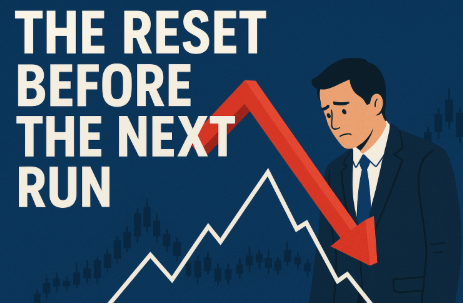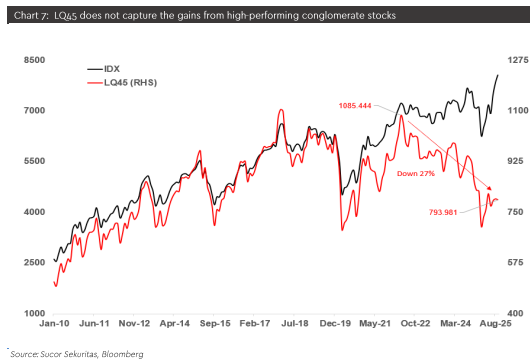15 October 2025
The Reset Before the Next Run
Market Commentary
0 comments

The market finally took a breather. After months of relentless rallies and euphoria around conglomerates, the Jakarta Composite Index (JCI) tumbled sharply. Dropping as much as 3% intraday to 7,974 before closing at 8,066. It looked painful, but in reality, this may be a sign of a healthy correction after a long overextension.
In recent months, the rally in Indonesia’s mid-tier and conglomerate stocks has pushed valuations far beyond their fundamental targets. According to our latest report, several of these names have soared three to fivefold, driving the JCI to record highs while leaving the broader market behind.
While the JCI has gained 15% year to date, the LQ45 Index, which better represents large-cap fundamentals, has actually fallen 27% over the past four years. The rally has become heavily concentrated, and today’s selloff simply marks the market’s attempt to rebalance.

Globally, risks are also rising. Volatility gauges like VVIX and VIX are showing early signs of tension amid fears of an AI-driven bubble and record-high S&P 500 valuations. This has made global investors more cautious and driven renewed foreign outflows from emerging markets.
.png)
But in every market cycle, there comes a turning point. When volatility spikes and investors rush for safety, sector rotation tends to begin, from high-beta cyclicals toward defensives and safe-haven assets like gold and consumer staples. The same pattern was seen during the 2008 Global Financial Crisis, when gold outperformed sharply after equities peaked.
.png)
Looking ahead, the JCI may continue to consolidate in the short term, especially as investors digest concerns over the state budget deficit and rising global volatility. Support is expected to form around the 7,900–7,950 zone, a level that has historically attracted strong buying interest. A temporary pullback toward this area would likely provide a healthier foundation for the next leg higher, paving the way for renewed accumulation once sentiment stabilizes.
This phase of correction, therefore, should be seen not as an ending, but as the start of a new accumulation cycle. As valuations cool off and volatility rises, investors with a long-term mindset can gradually rebuild exposure, especially in quality banks, energy, and consumer defensives that have lagged behind but maintain strong fundamentals.
In short, this isn’t the end of the cycle. It’s the market taking a pause before the next run. Smart investors buy when sentiment is weak, not when the crowd is euphoric.
In recent months, the rally in Indonesia’s mid-tier and conglomerate stocks has pushed valuations far beyond their fundamental targets. According to our latest report, several of these names have soared three to fivefold, driving the JCI to record highs while leaving the broader market behind.
While the JCI has gained 15% year to date, the LQ45 Index, which better represents large-cap fundamentals, has actually fallen 27% over the past four years. The rally has become heavily concentrated, and today’s selloff simply marks the market’s attempt to rebalance.

Globally, risks are also rising. Volatility gauges like VVIX and VIX are showing early signs of tension amid fears of an AI-driven bubble and record-high S&P 500 valuations. This has made global investors more cautious and driven renewed foreign outflows from emerging markets.
.png)
But in every market cycle, there comes a turning point. When volatility spikes and investors rush for safety, sector rotation tends to begin, from high-beta cyclicals toward defensives and safe-haven assets like gold and consumer staples. The same pattern was seen during the 2008 Global Financial Crisis, when gold outperformed sharply after equities peaked.
.png)
Looking ahead, the JCI may continue to consolidate in the short term, especially as investors digest concerns over the state budget deficit and rising global volatility. Support is expected to form around the 7,900–7,950 zone, a level that has historically attracted strong buying interest. A temporary pullback toward this area would likely provide a healthier foundation for the next leg higher, paving the way for renewed accumulation once sentiment stabilizes.
This phase of correction, therefore, should be seen not as an ending, but as the start of a new accumulation cycle. As valuations cool off and volatility rises, investors with a long-term mindset can gradually rebuild exposure, especially in quality banks, energy, and consumer defensives that have lagged behind but maintain strong fundamentals.
In short, this isn’t the end of the cycle. It’s the market taking a pause before the next run. Smart investors buy when sentiment is weak, not when the crowd is euphoric.
Written by Boris, the Broker
Comments